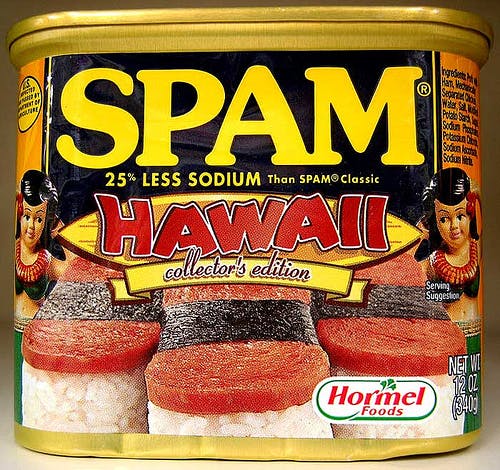Spending any time in Hawaii may cause you to ask an age-old question: What’s in SPAM?
This canned food is sold and eaten across the world, but it’s especially popular in Hawaii, where you can find an assortment of dishes featuring it.
But if you’re wondering what’s inside the colorful tin cans, we’ll first look at the name of the food. Despite its many nicknames, SPAM simply stands for “spiced ham.”
But there’s still more to know about what’s in this popular food.
6 Simple Ingredients
SPAM boasts that it’s made out of six simple ingredients, though really it’s a bit more than that. The full ingredient list is: pork shoulder with pork ham meat, salt, water, potato starch, sugar, and sodium nitrite. Flavored varieties may include more spices and seasonings.
SPAM’s Popularity in Hawaii
In Hawaii, the meat manages to sneak into almost every dish – saimin, fried rice, or the infamous SPAM musubi – the all-encompassing Hawaiian power bar.
It’s because of this that Hawaii consumes the most SPAM per capita.
What can we say, Hawaii loves SPAM! So much, that we’re one of the only places where fast-food chains like McDonald’s and Burger King include it on their menus. And don’t forget about the annual Waikiki Spam Jam. That should speak for itself!
If you’re like the other half of the world that scoffs at SPAM, then you’re probably laughing by now. Yes, a festival of SPAM. But in our defense, we’re not the only ones! Austin, Minn. (the home of Hormel SPAM) has a festival and a museum. Farther west, Oregon honors the canned meat with an annual parade and festival.
What’s in a Name: SPAM Beyond Hawaii
One of SPAM’s most accepted nicknames is “Special Army Meat,” which came about during WWII. Because fresh meat was difficult to get to soldiers in combat, the canned pork served as the next best thing. Soldiers got cans by the crates and ate it for breakfast, lunch and dinner.
The extra cans eventually made their way into the diets of people living in the area. Hence, you’re bound to find SPAM in Hawaii, Guam, Okinawa, and the Philippines – all Pacific places occupied by the U.S. at one time or another.
At one point after the war, SPAM became a symbol of American patriotism, believe it or not. Hormel Foods assembled a troupe of former G.I. women called the Hormel Girls, who promoted the meat from coast to coast. They eventually grew to as many as 60 women just a few years later and started a radio program to market the meat.
Perhaps learning what’s in SPAM grossed you out, or maybe it made you crave the popular food. But hopefully it gave you a better understanding of its role in Hawaii. And maybe next time you’re here, you’ll brave the waters and try the meat that’s not so mysterious after all!




